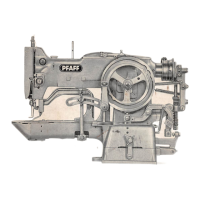Vu", or 7 to 8 mm,
between
the tip of the
bobbin
thread
knife
and
the
needle hole when the knife is inoperative (Fig. 35). Except when the machine
makes
the
last
stitch
of
o
tack
and
the
first
four
stitches
of
the
next
tack
the
knives remain at their inoperative position throughout the sewing cycle.
(2)
Knife Cam
Shortly
before
the machine stops, the knife com causes the knives to
swing forward from the inoperative to the stand-by position. At the same
time, the needle thread loop formed during the lost stitch is pulled over
the back
edge
of the needle thread knife. The bobbin thread is caught
simultaneously by the tip of the
bobbin
thread
knife
and
pulled sideways
so that it is positioned in front of its cutting edge. The threads, however,
are
not cut until the left treadle is depressed to raise the work clamp after the
machine has
stopped.
The knife com is screwed to a positioning flange and, hence, can be
easily rotated on the worm wheel shaft.
By
turning the knife cam on its
shaft, the trimming action can be precisely synchronized with the needle
motion. The trimming action normally should stort when the needle begins
to descend for its last stitch. (The
gear
ratio between worm
and
worm wheel
is 1:42).
Make particularly sure that the needle is not deflected by one of the
knives
or even strikes them. Also
check
to see that the shuttle grips the
needle
thread
loop securely as the
needle
ascends
after
the last stitch has
been
made.
Take
care
that
the
needle
does
not
come
into
contact
with
the
knives
when
the
machine
makes
the
first four stitches of
the
next tack. If
the knife cam is designed to make more than one tack per revolution
(there ore 2-, 3-, 4-, and
6-cycle
cams), the
trimming
action must be
checked
for each needle cycle. If the settings should differ, use an intermediate
setting.
To make sure that the play
which
might be present in the
trimming
mechanism
does not cause the needle to hit the
knives
occasionally, turn the driving
pulley clockwise (as viewed from the rear), and see whether the needle
contacts the
knives.
If adjustment is needed, correct the setting of the knife
bar.
After the knives have been set correctly, depress the treadle to see wheth
er the
lifting
lever turns easily. As the treadle is depressed, the roller at the
top end of the knife bar tripping lever must snap into the depression in the
channel
track
of
the
knife
cam.
With machines having different gear ratios,
such
as
1:21, 1:28,
and 1:36,
minor
deviations
from
the above
setting
may
be
necessary.
On
machines
having
a
1:28
gear
ratio,
for
instance,
the
knives
must
be set to
swing
for
ward to the stand-by position somewhat later.
48

